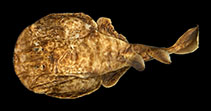| Family: |
Narcinidae (Numbfishes) |
| Max. size: |
16 cm TL (male/unsexed); 30.6 cm TL (female) |
| Environment: |
benthopelagic; marine; depth range - 60 m |
| Distribution: |
Eastern Indian Ocean: off eastern Indonesia. |
| Diagnosis: |
This species of is distinguished from its congeners by the following characters: dorsal color pattern unique, composed of large, circular, ovoid or elongate dark brown blotches on dorsal disc, interspersed with more numerous small (about eye-sized or greater) brownish, circular to ovoid spots, with large and small spots and blotches surrounded by a very slender creamy-white pattern, on a light brown to tan background color; differs from N. brevilabiata and N. atzi (which also possess few large brownish spots or blotches and numerous smaller spots) by having much fewer small spots or blotches and having the creamy-white, slender outline surrounding large and smaller spots and blotches on dorsal mid-disc; differs from N. brevilabiata by having much fewer small dark spots (vs. many small dark spots) and having tooth bands of subequal width that are broadly circular in outline (vs. strongly subtriangular tooth bands, with upper tooth band clearly wider than lower tooth); differs from N. antzi by having fewer smaller spots (vs. more numerous small spots, smaller than eye-diameter) and with dorsal fins subequal in height and length of base or first dorsal fin just slightly greater than second (vs. first dorsal fin conspicuously greater and with longer base than second dorsal fin).
Narcine baliensis is also distinguished from the Indo-West Pacific and Indian Ocean species N. maculata, N. lingula and N. prodorsalis, by having the preoral distance greater than preorbital distance (about equal in former three species); and from the western Indian Ocean N. oculifera and N. insolita, N. baliensis is further distinct in having dorsal fins of subequal size (first dorsal fin much larger than second in N. oculifera and N. insolita) (Ref. 116737). |
| Biology: |
The biology of this species is largely unknown, but presumed to feed on small benthic invertebrates as do other numbfishes. Females are presumed to be sexually mature at 30.6 cm TL; max length of 16.0 cm TL is that of an adolescent male (Ref. 116737). |
| IUCN Red List Status: |
Near Threatened (NT); Date assessed: 20 May 2020 (A2d) Ref. (130435)
|
| Threat to humans: |
harmless |
Source and more info: www.fishbase.org. For personal, classroom, and other internal use only. Not for publication.

